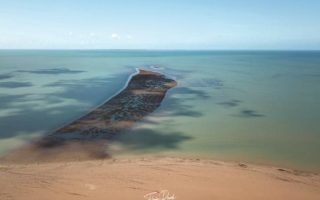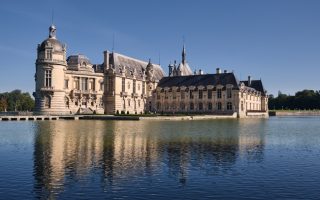Exploring les Deux Charentes on France’s Atlantic Coast
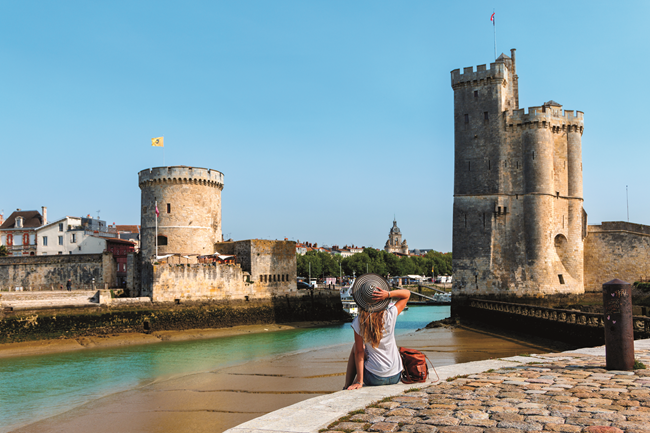
Experience the double delight of exploring ‘Deux Charentes’ in one trip – the adjoining Charente-Maritime and Charente departments, which combine coastal charm, irresistible towns and rural idylls.
In the summer, up to nine TGVs a day glide out of Paris’s Gare Montparnasse, headed for La Rochelle on the Atlantic coast. This is where the well-heeled denizens of France’s capital city choose to take their holidays. Not for them the brash, ostentatious seaside resorts of the Midi – they’d much rather enjoy the more understated and frankly cooler (both in temperature and style) coastal region of Charente-Maritime. And the coolest of all is a 30km island called the Île de Ré, more of which later.
There are two neighbouring Charente departments – Charente and Charente-Maritime. The former is slightly inland, incorporating Cognac and Angoulême; the latter occupies a lovely section of Atlantic coast stretching from the mouth of the Gironde river in the south up to the Île de Ré and La Rochelle in the north. Thanks to its airport with links to the UK, it’s in La Rochelle that our driving tour of the Deux Charentes starts. There are four ports in this pretty university town the fishing port, the commercial port, the yachting port and, slap bang in the centre, the old port. Add to that three city beaches the central Plage de la Concurrence, the more studenty Plage des Minimes and the slightly grubbier Plage de Chef de Baie over to the west, where locals like to hide from the tourists.
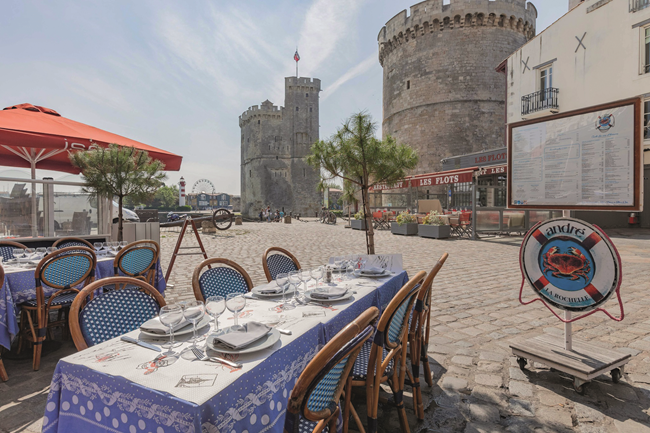
Modern La Rochelle owes much of its character to Mayor Michel Crépeau who ruled the roost in the 1970s, 80s and 90s. Politically a socialist, he was an early adopter of green policies: his legacy can still be seen in the fleets of public transport that serve the town the buses, the boats, the electric car-sharing scheme (Yélomobile) and the bike-share scheme (Yélovelo).
Unfortunately Crépeau couldn’t do anything about La Rochelle’s massive, Brutalist German U-boat station, constructed during the Second World War. The Allies tried their best to destroy it but it turned out to be utterly bombproof. All attempts to remove it after the war also failed, so it remains to this day – abandoned, immovable and as ugly as ever.
Much easier on the eye is the Tour de la Lanterne, past the mouth of the old port. This 15th-century spired construction used to be a lighthouse and later became a prison. Climbing up through its eight floors, you see the hundreds of graffiti images and words etched into the walls by the poor souls once imprisoned there. There are two other towers, guarding either side of the entrance to the old port, one a museum, the other a labyrinth of chambers, staircases and passageways. Also well worth visiting is the Musée Maritime and La Rochelle Aquarium.

Monument Michel Crepeau © Charentes Tourisme
Island life
By now you’ll be craving the seaside. Driving west out of La Rochelle, you cross the toll bridge onto the Île de Ré, without doubt one of the stand-out destinations on the west coast. If you can, dump the car and hire a bicycle to explore the fishing port of Saint-Martin-de-Ré, the beautiful sandy beaches, the isolated coves, the salt and oyster beds, and the green-shuttered, whitewashed cottages that dot the island.
From the Île de Ré, our tour heads east, back onto the mainland and along the N11 motorway to the Parc Naturel Régional du Marais Poitevin. This vast maze of streams, green pools, hidden marshes and ruined churches is nicknamed La Venise Verte. Created when Dutch engineers built a series of canals through the existing marsh in the 17th century, it’s best explored by boat. Stretched across three departments, it dips into the north of the Charente-Maritime. La Ronde is one village where you can hire boats.
Now it’s time for the Charente department. First drive south to Saint-Jean-d’Angély and then on the D939 to Angoulême. Sitting on a plateau, overlooking the River Charente, this hilly city is the department capital. The architecture is interesting, but outside of France it is better known as host of the annual comic book festival, the Festival International de la Bande Dessinée. Staged in January, this sees the entire town transformed into a huge celebration of every possible aspect of comic-book culture from Japanese manga and American super-heroes to Francophone classics such as Tintin, Lucky Luke and Asterix and Obelix. At multiple venues there are exhibitions, lectures, shows, workshops, book signings and innumerable book stalls. The next festival is from January 25 to 28, 2024
Come outside of these dates, though, and you can either visit La Cité Internationale de la Bande Dessinée et de l’Image – with a museum, library, bookshop and cinema dedicated to the art form or book a guided tour of the many colourful comic-book murals emblazoned around town.
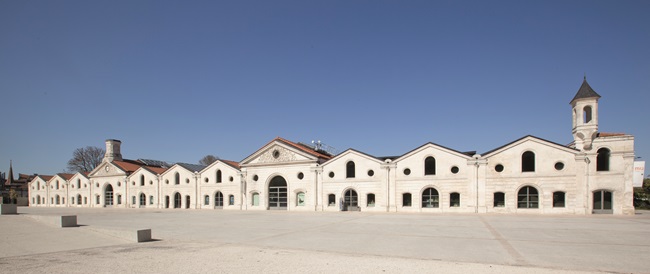
Angoulême’s comic book museum © Chais Magelis
That’s the spirit
From Angoulême it’s a short drive west to Cognac, the world capital of the very best brandy. Here, feel free to stuff yourself with the richest of French food in the knowledge you can always aid digestion with a large glass of cognac.
It’s a fine-looking town, lined with half-timbered 15th- to 17th-century houses and dissected by the River Charente. But you’re not here to admire the architecture. Park the car and head for one of the many cognac houses that open their doors for tastings: Otard, Rémy Martin, Camus, Hennessy, Meukow, Martell…take your pick and drink responsibly, bien sûr.
From Cognac, it’s a short skip, following the course of the River Charente back into the Charente-Maritime department and to Saintes, a grand town with plenty to remind you of its Roman past, including the Arc de Germanicus, the cathedral and the Abbaye aux Dames. Most impressive of all is the amphitheatre, les Arènes gallo-romaines.
By now, you’re almost back at the coast. First head to Royan, a popular beach town which bore the brunt of Allied bombing during the Second World War – little remains of the Belle Époque – buildings which once graced it. In the 1950s, it became a test city for post-war architectural experimentation and is now considered a showcase of the Modernist style. If uncompromisingly bold concrete is your cup of tea, then check out Gillet and Hébard’s Church of Notre-Dame, Claude Ferret’s Palais des Congrès, and Simon and Morisseau’s central market. To unwind, there are plenty of beaches, including the 3km-long Grande Conche.
From here, drive north and cross the Pont Viaduc d’Oléron to the Île d’Oléron, France’s second largest island after Corsica. Here, tiny fishing villages share space with sandy beaches, marshlands, oyster farming and ancient fortifications. The best beach of all is at La Brée-les-Bains, up towards the northern tip.
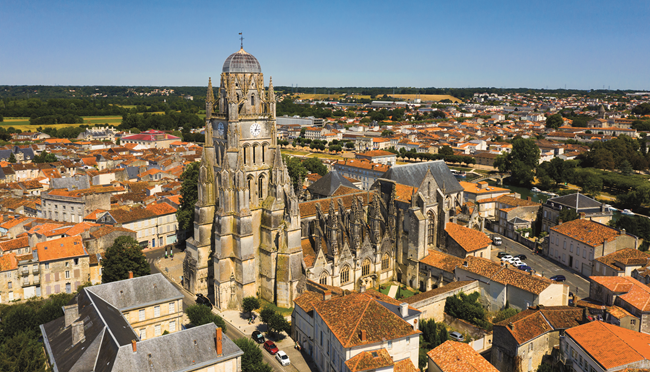
The flamboyant Gothic cathedral at Saintes © shutterstock
Strategic waterside
Back on the mainland, it’s a short drive north to Rochefort. Hugging the northern bank of a huge meander in the River Charente, in centuries past this town was home to France’s most hi-tech naval shipyards. Just five miles as the crow flies from the Atlantic coast, but strategically positioned several twists and turns upriver out of reach of enemy fleets, it was the perfect hiding place for the French navy to build its best warships. The surrounding marshland put paid to any land attacks.
Still today, the riverbanks and estuary between Rochefort and the sea bristle with former military forts, most notably Fort Boyard, home to French TV’s famous game show of the same name. Starring a host of bizarre characters and scary beasts, it tests contestants across various physical and endurance challenges. There was also a UK version filmed here in the late 1990s and early 2000s. Unfortunately, tourists aren’t allowed to visit the fort itself, but you can enjoy a boat trip that will take you tantalisingly close.
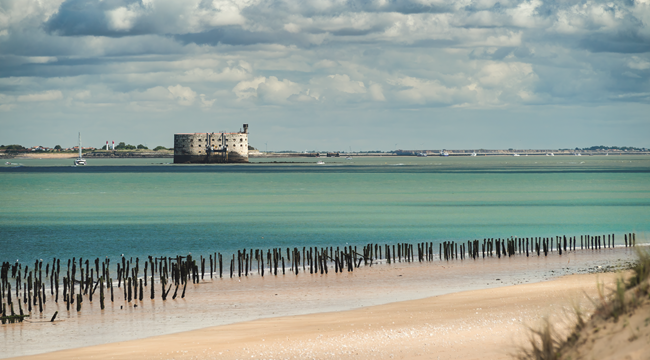
Fort Boyard © shutterstock
Tourists can, however, visit the various islands in the bay. The most impressive of these is the Île d’Aix, which is just 300 acres and is home to barely 200 full-time inhabitants, plus some lovely beaches and a museum dedicated to Napoleon. It turns out the vertically-challenged dictator sought refuge here in 1815 after he’d been routed at the Battle of Waterloo. Unsure of where to turn, he spent his final days of freedom here before surrendering to the British and heading off to see out his life at their majesty’s leisure on the island of Saint Helena.
Rochefort’s most unusual landmark is its transporter bridge. This is a moving platform that glides across the river, hanging by cables from a bridge above it, allowing vast ships to pass. Nowadays it’s been superseded by a huge suspension bridge but still functions as a tourist attraction and is one of only a dozen or so such bridges worldwide.
Now for the last leg of this Deux Charentes tour. From Rochefort, take the autoroute north, stopping at Châtelaillon-Plage for a swim. Then it’s just a few kilometres back to La Rochelle, where you started.
From France Today magazine
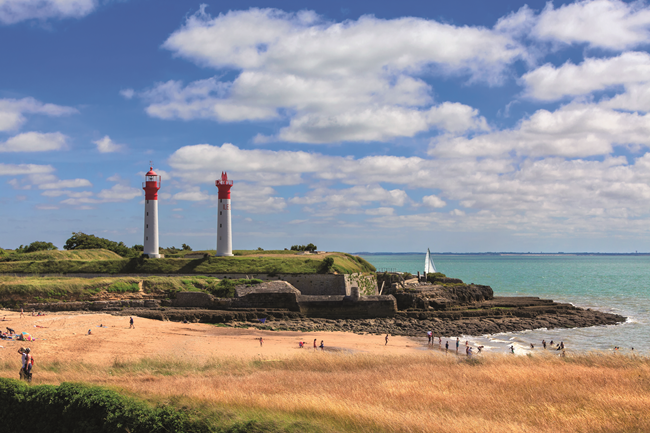
Ile d’Aix © shutterstock
Lead photo credit : The iconic towers at the entrance to La Rochelle’s picturesque Vieux Port, © shutterstock
Share to: Facebook Twitter LinkedIn Email
More in Atlantic coast, charente, Charente-Maritime, coastal towns, French islands, west coast, western France
Leave a reply
Your email address will not be published. Required fields are marked *

